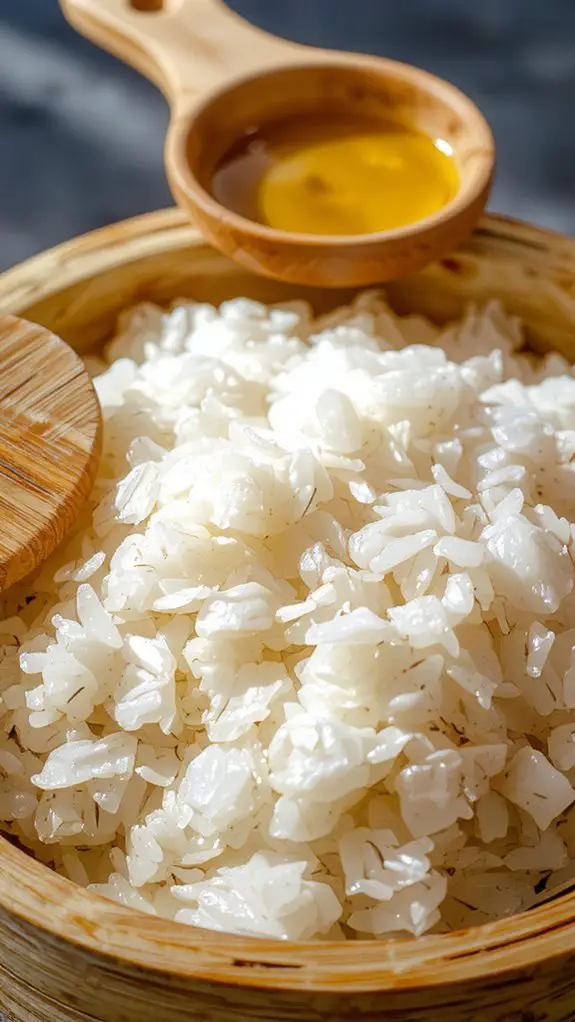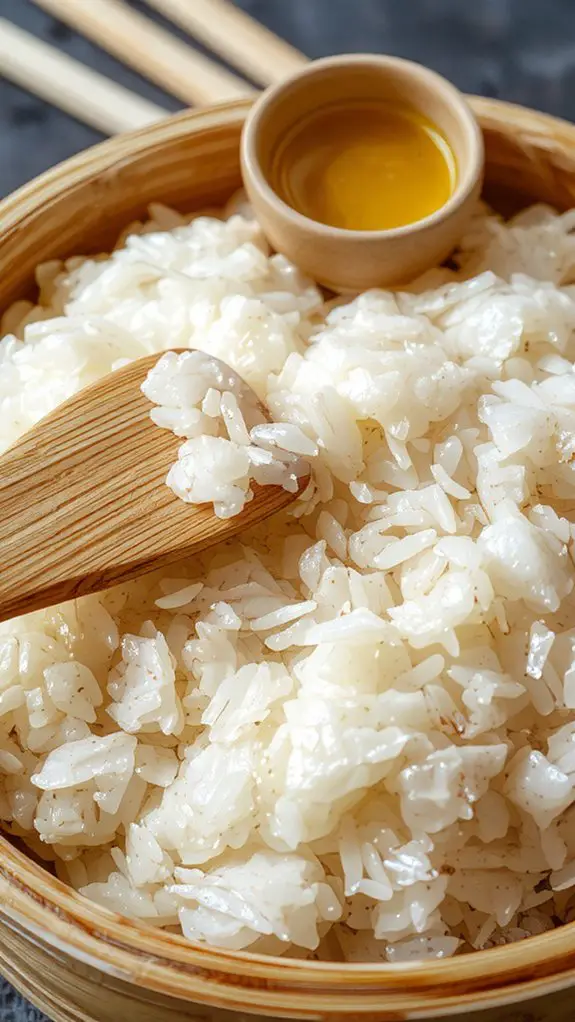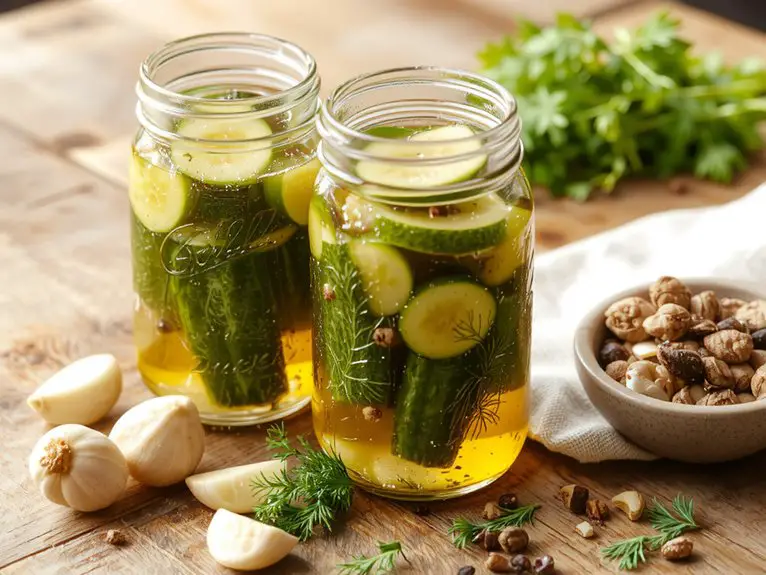Recipe
If there’s one thing I’ve learned after making sushi rice countless times, it’s this: the secret to unforgettable sushi lies in the rice. Sounds simple, right? But trust me, when done right, it’s a game-changer.
Using just a handful of pantry staples—Japanese short-grain rice, rice vinegar, sugar, and salt—you can create a base that’s sticky, slightly sweet, and perfectly seasoned. I’ll never forget the first time I nailed the balance; it was the moment I realized homemade sushi could rival any restaurant dish.
The rice should be tender but firm, with a glossy sheen that clings beautifully to your fillings. Once you taste it, you’ll understand why sushi rice isn’t just a sidekick—it’s the star.
And the best part? It’s way easier to make than you think. Let’s get started.
Ingredients
The secret to perfect sushi rice lies in the ingredients—quality matters here, and cutting corners will show in the final texture and flavor. While some swaps work, there are a few non-negotiables if you want that authentic, glossy, slightly sticky rice that holds together without being gummy.
- Short-grain Japanese rice (sushi rice) – *Must use this!* The high starch content gives sushi rice its signature stickiness. Brands like Koshihikari or Tamaki Gold are chef favorites. Don’t sub with long-grain or jasmine rice—it won’t work.
- Rice vinegar – The acidity balances the sweetness. Seasoned rice vinegar (with sugar and salt added) saves time, but if using plain, you’ll need to adjust with sugar and salt (see below).
- Sugar – *Essential* for that subtle sweetness. Granulated white sugar dissolves best, but you can sub with caster sugar in a pinch.
- Salt – Just a pinch to enhance flavor. Sea salt or kosher salt works; avoid iodized salt, which can taste metallic.
- Kombu (dried kelp) – *Optional but highly recommended.* A small piece steeped in the cooking water adds umami depth. Remove before boiling!
Pro Tip: Rinse the rice *thoroughly* until the water runs clear—this removes excess starch and prevents mushiness.
No kombu? A tiny splash of mirin (sweet rice wine) can add complexity, but don’t overdo it—it’s sweeter than kombu.
How to Make the Best Perfect Sushi Rice Formula

Mix the sushi vinegar gently. Combine rice vinegar, sugar, and salt in a small saucepan, heating until dissolved. This blend adds flavor and helps the rice stick together.
Fold the vinegar into the rice using a cutting motion with a wooden spoon or rice paddle. Be gentle to avoid crushing the grains.
Spread the rice in a flat layer**** to cool it quickly, which prevents it from becoming too sticky.
Fan the rice while mixing to remove excess moisture and create a shiny, polished texture. Use a handheld fan or a piece of cardboard to gently wave air over the rice.
Keep the rice covered with a damp cloth**** until ready to use. This prevents it from drying out and maintains its ideal consistency for rolling sushi.
Pro Tip: Use a non-metallic bowl for mixing the rice and vinegar. Metal can react with the vinegar and alter the flavor.
Watch-Out Warning: Avoid overmixing the rice after adding the vinegar, as this can break the grains and make the rice mushy. Aim for a light, even coating.
Flexibility: If the rice feels too sticky, let it sit uncovered for a few minutes to release excess moisture.
Adjust the vinegar mixture to taste, adding more sugar for sweetness or salt for balance.
Visual Cue: Perfect sushi rice will be slightly sticky but retain individual grain definition. It should hold together when pressed but not feel overly wet or clumpy.
Time-Saving Trick: Prepare the sushi vinegar mixture in advance and store it in an airtight container. It’s ready to use whenever you make sushi rice.
Nutrition
Sushi rice is a staple in Japanese cuisine, providing essential nutrients in every bite. Below is the nutritional breakdown per serving.
| Nutrient | Amount Per Serving |
|---|---|
| Calories | 240 kcal |
| Carbohydrates | 53 g |
| Protein | 4 g |
| Fat | 0.5 g |
| Fiber | 0.7 g |
| Sodium | 10 mg |
Chef Tips
Perfecting sushi rice starts with selecting the right short-grain variety—it’s stickier and holds together better for rolls and nigiri.
I always rinse it until the water runs clear to remove excess starch.
Use a wooden bowl to mix in the vinegar—it absorbs moisture better.
Fan the rice while folding to cool it quickly and achieve that perfect glossy finish.
Don’t skip resting it covered for 10 minutes before shaping.
Frequently Asked Questions
Can I Use Regular Rice Instead of Sushi Rice?
I can use regular rice, but it won’t have the same sticky texture as sushi rice. Sushi rice’s short grains and higher starch content make it ideal for rolling. If I use regular rice, it might fall apart.
How Long Does Sushi Rice Stay Fresh?
Sushi rice stays fresh for about a day if I keep it at room temperature, but it’ll last up to 2-3 days if I refrigerate it. I’ll cover it tightly to prevent it from drying out or absorbing odors.
Can I Freeze Cooked Sushi Rice?
Yes, I can freeze cooked sushi rice. I’d cool it, pack it in airtight bags or containers, and label it. When I need it, I’ll thaw it in the fridge and reheat gently to restore texture.
What’s the Best Way to Reheat Sushi Rice?
I usually reheat sushi rice in a microwave with a damp towel over it to keep it moist. If I’m using a stovetop, I’ll steam it gently, stirring occasionally to avoid drying it out.
Is Sushi Rice Gluten-Free?
Yes, sushi rice is gluten-free as it’s made from short-grain rice, vinegar, sugar, and salt, which don’t contain gluten. I’d make sure the rice vinegar you use is certified gluten-free to avoid any cross-contamination.










